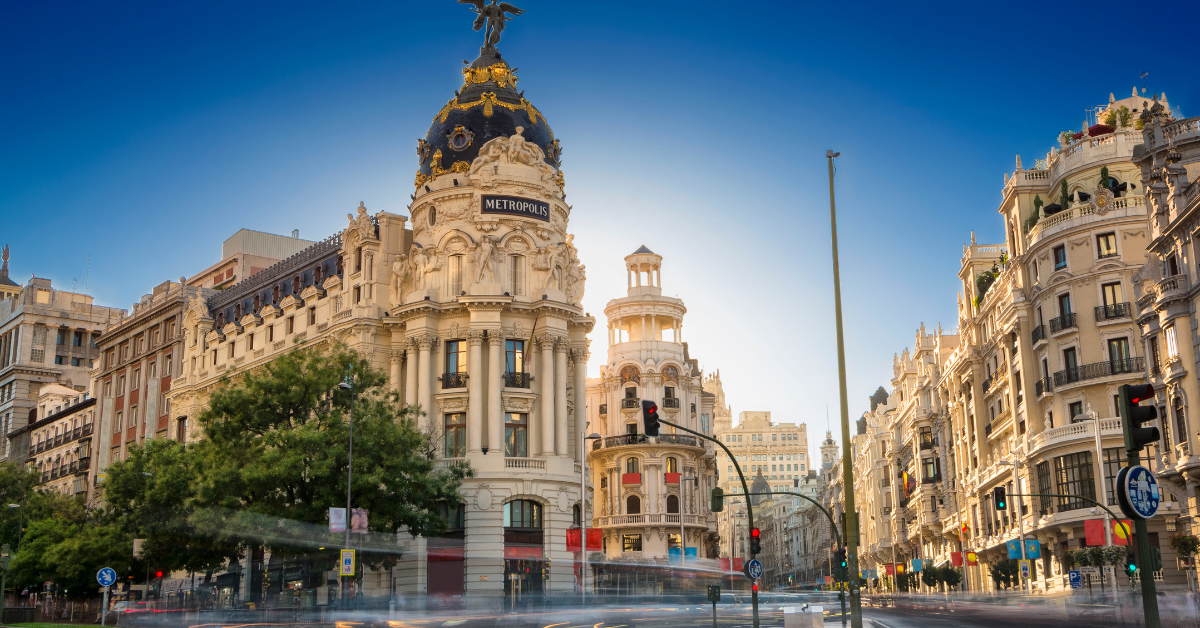Madrid, the capital of Spain, is sometimes written in Japanese Kanji as “馬徳里.” This form does not translate the meaning but represents the sound of the name. For Japanese readers, this Kanji evokes not only linguistic history but also unique cultural associations with Madrid, such as soccer, art, and passionate traditions.
Why Madrid is Written as “馬徳里”
The Kanji “馬徳里” does not translate Madrid’s meaning but instead focuses on reproducing its sound. “馬” represents “Ma,” “徳” represents “Do,” and “里” represents “Ri,” creating a phonetic approximation.
Such transcriptions are widely found across Kanji-using cultures such as Japan, China, and Taiwan, where foreign place names were often expressed through characters that captured their sounds.
Here are some representative examples of city names in Kanji:
| City | Kanji Writing | Pronunciation |
|---|---|---|
| London | 倫敦 | Rondon |
| Paris | 巴里 | Pari |
| New York | 紐育 | Nyūyōku |
| Madrid | 馬徳里 | Madorīdo |
This table shows that Kanji expressions were intended to reproduce sound, not meaning. “馬徳里” remains part of Japan’s linguistic and cultural history.
Historical Background of Madrid’s Kanji Usage in Japan
The habit of writing foreign cities in Kanji spread during the Meiji to early Shōwa periods, especially in newspapers and printed works. At the time, Katakana was not yet widely used, and the Roman alphabet was understood only by limited groups. Thus, Kanji was seen as more accessible and reader-friendly.
“馬徳里” became common in this context but later gave way to the Katakana “マドリード” (Madorīdo). Today, the Kanji version survives mostly in historical documents and old publications, providing a glimpse into the social and linguistic climate of those times.
| Period | Dominant Form | Characteristics |
|---|---|---|
| Meiji Era | Kanji writing | Widely used in newspapers and journals |
| Early Shōwa | Mixed Kanji and Katakana | Gradual decline of Kanji usage |
| Modern Day | Katakana writing | “マドリード” is standard |
The Image of Madrid in Japan
Madrid is a city with many faces, and the Japanese perception of it is equally diverse.
The City of Soccer
Real Madrid is one of the world’s most famous soccer clubs and a symbol of excellence admired by Japanese fans. Its history of triumphs in European and domestic competitions has deeply shaped Madrid’s global reputation.
Additionally, Atlético Madrid represents another powerhouse from the same city. The rivalry between the two culminates in the “Madrid Derby,” a globally anticipated event.
| Club | Features | Impression in Japan |
|---|---|---|
| Real Madrid | World-renowned, countless titles | Symbol of soccer, glamour |
| Atlético Madrid | Strong defense, relentless spirit | Represents effort and passion |
A City of Art and Culture
The Prado Museum and other institutions make Madrid synonymous with artistic and cultural richness. Japanese exhibitions of Velázquez and Goya’s works have reinforced its image as a hub of European fine art.
Passion and Tradition
Madrid is also associated with flamenco and bullfighting, symbols of Spanish passion and energy. For Japanese people, this creates an impression of Madrid as a vibrant, lively city filled with tradition.
Madrid as a City of Sports
Madrid’s sports culture extends well beyond soccer. It also plays a significant role internationally in tennis and basketball.
Tennis
The Madrid Open is a globally prestigious tournament. Japanese fans remember it vividly for Kei Nishikori’s outstanding performances, strengthening Madrid’s reputation among tennis enthusiasts.
Basketball
Real Madrid Basketball is one of Europe’s strongest teams, consistently ranking at the top in domestic and international competitions.
| Sport | Club / Event | Features |
|---|---|---|
| Soccer | Real Madrid, Atlético Madrid | Two globally renowned clubs in one city |
| Tennis | Madrid Open | Attracts top-ranked players worldwide |
| Basketball | Real Madrid Basketball | Among Europe’s elite clubs |
Conclusion
Madrid’s Kanji representation “馬徳里” is rooted in the tradition of phonetic transcription, emphasizing sound over meaning. While it has fallen out of everyday use, it remains an important marker of Japan’s linguistic history.
At the same time, Madrid holds a multi-layered image in the eyes of the Japanese. It is seen as the city of soccer, the center of art and culture, a hub of passionate traditions, and an international sports capital.
Through the lens of “馬徳里,” we see more than just a name—we see the deep cultural and emotional connection between Japan and Madrid, where sports, art, history, and tradition intertwine to form one of Europe’s most compelling capitals.






